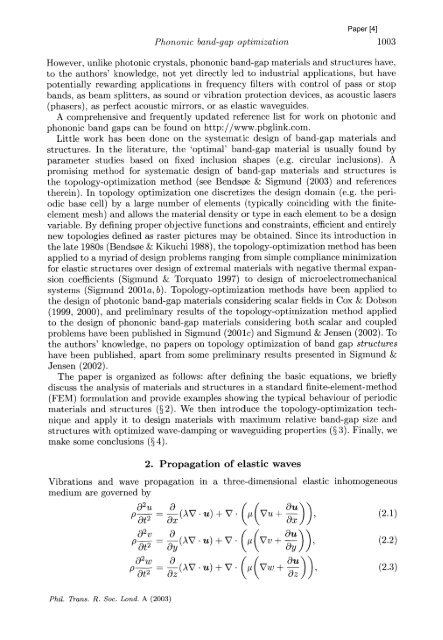WAVES AND VIBRATIONS IN INHOMOGENEOUS STRUCTURES ...
WAVES AND VIBRATIONS IN INHOMOGENEOUS STRUCTURES ...
WAVES AND VIBRATIONS IN INHOMOGENEOUS STRUCTURES ...
Create successful ePaper yourself
Turn your PDF publications into a flip-book with our unique Google optimized e-Paper software.
Phononic band-gap optimization<br />
However, unlike photonic crystals, phononic band-gap materials and structures have,<br />
to the authors' knowledge, not yet directly led to industrial applications, but have<br />
potentially rewarding applications in frequency filters with control of pass or stop<br />
bands, as beam splitters, as sound or vibration protection devices, as acoustic lasers<br />
(phasers), as perfect acoustic mirrors, or as elastic waveguides.<br />
A comprehensive and frequently updated reference list for work on photonic and<br />
phononic band gaps can be found on http://www.pbglink.com.<br />
Little work has been done on the systematic design of band-gap materials and<br />
structures. In the literature, the 'optimal' band-gap material is usually found by<br />
parameter studies based on fixed inclusion shapes (e.g. circular inclusions). A<br />
promising method for systematic design of band-gap materials and structures is<br />
the topology-optimization method (see Bends0e & Sigmund (2003) and references<br />
therein). In topology optimization one discretizes the design domain (e.g. the peri-<br />
odic base cell) by a large number of elements (typically coinciding with the finite-<br />
element mesh) and allows the material density or type in each element to be a design<br />
variable. By defining proper objective functions and constraints, efficient and entirely<br />
new topologies defined as raster pictures may be obtained. Since its introduction in<br />
the late 1980s (Bends0e & Kikuchi 1988), the topology-optimization method has been<br />
applied to a myriad of design problems ranging from simple compliance minimization<br />
for elastic structures over design of extremal materials with negative thermal expan-<br />
sion coefficients (Sigmund & Torquato 1997) to design of microelectromechanical<br />
systems (Sigmund 2001a, b). Topology-optimization methods have been applied to<br />
the design of photonic band-gap materials considering scalar fields in Cox & Dobson<br />
(1999, 2000), and preliminary results of the topology-optimization method applied<br />
to the design of phononic band-gap materials considering both scalar and coupled<br />
problems have been published in Sigmund (2001c) and Sigmund & Jensen (2002). To<br />
the authors' knowledge, no papers on topology optimization of band gap structures<br />
have been published, apart from some preliminary results presented in Sigmund &<br />
Jensen (2002).<br />
The paper is organized as follows: after defining the basic equations, we briefly<br />
discuss the analysis of materials and structures in a standard finite-element-method<br />
(FEM) formulation and provide examples showing the typical behaviour of periodic<br />
materials and structures (? 2). We then introduce the topology-optimization tech-<br />
nique and apply it to design materials with maximum relative band-gap size and<br />
structures with optimized wave-damping or waveguiding properties (? 3). Finally, we<br />
make some conclusions (? 4).<br />
2. Propagation of elastic waves<br />
Vibrations and wave propagation in a three-dimensional elastic inhomogeneous<br />
medium are governed by<br />
02 =<br />
Phil. Trans. R. Soc. Lond. A (2003)<br />
1003<br />
, (AV .u) +V ( v+ )), (2.1)<br />
POt2 a ax<br />
Pt2 = 0(V u) + V Vv + (2.2)<br />
P2 = (V ) + IV<br />
POt2 - a(X V Vw + (2.3)<br />
u + '

















